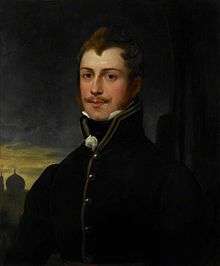Claudius Rich
Claudius James Rich (28 March 1787 – 5 October 1821) was a British business agent, traveller and antiquarian scholar.[1]

Biography
Rich was born near Dijon[2] 'of a good family', but passed his childhood at Bristol. Early on, he developed a gift for languages, becoming familiar not only with Latin and Greek but also with Hebrew, Syriac, Persian, Turkish and other Eastern tongues. In 1803, by the influence of friends, he was appointed a cadet in the East India Company's service. The following year he went to Constantinople, where, and at Smyrna, he stayed some time, perfecting himself in Turkish.
Proceeding to Alexandria as assistant to the British consul-general there, he devoted himself to Arabic and its various dialects, and made himself master of Eastern manners and usages. On leaving Egypt he travelled by land to the Persian Gulf, disguised as a Mamluk, visiting Damascus, and entering the great mosque undetected. At Bombay, which he reached in September 1807, he was the guest of Sir James Mackintosh, whose eldest daughter Mary he married on 22 January 1808, proceeding soon after to Baghdad as the British Resident.
There he began his investigations into the geography, history and antiquities of the district. He explored the remains of Babylon, and projected a geographical and statistical account of the pashalic of Bagdad. The results of his work at Babylon appeared first in the Vienna serial Mines de l'orient, and in 1839 in London under the title Narrative of a Journey to the Site of Babylon in 1811.
In 1813-14 Rich spent some time in Europe, and on his return to Bagdad devoted himself to the study of the geography of Asia Minor, and collected much information in Syriac and Chaldean Christian convents concerning the Yezidis. During this period he made a second excursion to Babylon, and in 1820 undertook an extensive tour of the Chaldean villages in the north of present-day Iraq, alongside al-Munshi al Baghdady[3]—from Bagdad north to Sulaimaniya, eastward to Sinna, then west to Nineveh, and thence down the Tigris to Bagdad. The narrative of this journey, which contained the first accurate knowledge (from scientific observation) regarding the topography and geography of the region, was published by his widow under the title, Narrative of a Residence in Koordistan and on the site of Ancient Nineveh, etc. (London, 1836).
During his time in Baghdad it is recorded that "Mr Rich was universally considered to be the most powerful man in Baghdad; and some even questioned whether the Pasha himself would not shape his conduct according to Mr Rich's suggestions and advice rather than as his own council might wish."[4]
In 1820 Rich went to Basra, whence he made an excursion to Shiraz, visiting the ruins of Persepolis and the other remains in the neighborhood. In the same year he went to Mosul and the site of ancient Nineveh, where he was told of a large relief panel that had been found and soon broken up. When his account was published in 1836 it represented the first Western inkling of the Assyrian palace reliefs that were to be discovered in the 1840s; he also brought back two small fragments.[5]
He was then appointed to an important office at Bombay by Mountstuart Elphinstone, when he was attacked by cholera, during a visit to Shiraz, while exerting himself to help the sick and allay the panic among the inhabitants. He died on 5 October 1821 and was buried in the Jân Numâ, one of the royal gardens at Shiraz, in which he was living at the time of his death. In 1826 his remains were exhumed and reburied in the Armenian cathedral of Jolfa in Esfahan.[6]
His collections were purchased by the trustees of the British Museum, and consisted of 'about nine hundred volumes of manuscripts in Arabic, Persian, and Turkish, and a great number in Chaldee and Syriac … highly rated by Mr. Colebrooke and Dr. Wilkins';[7] a large collection of coins, Greek and oriental; gems, and antiquities dug up at Babylon and Nineveh, including the first cuneiform inscriptions ever brought to Europe. Rich's portrait, presented by his widow Mary Mackintosh Rich, hangs in the students' room of the manuscript department in the British Museum.
Sources
-

- Bringing Home the Exotic Archived 21 June 2011 at the Wayback Machine, Claudius James Rich, nysoclib, accessed August 2010
- Jwaideh, Wadie (2006). The Kurdish national movement : its origins and development (1. ed.). Syracuse, NY: Syracuse Univ. Press. p. 350. ISBN 0-8156-3093-X.
- Buckingham, J.S. (1928). Travels in Mesopotamia. 2. p. 200.
- Reade, Julian, Assyrian Sculpture, p. 6, 1998 (2nd edn.), The British Museum Press, ISBN 9780714121413
- Lane-Poole, Stanley (3 January 2008). "Rich, Claudius James (1786/7–1821), traveller and collector of manuscripts and antiquities". Oxford Dictionary of National Biography. doi:10.1093/ref:odnb/23483. Retrieved 28 July 2019.
- Trustees' Original Letters, British Museum Volume v.
- Attribution
![]()
Bibliography
- Rich, Claudius James (1818), Memoir on the ruins of Babylon (3 ed.), Longman, Hurst, Rees, Orme, and Brown
- Rich, Claudius James (1818), Second memoir on Babylon : containing an inquiry into the correspondence between the ancient descriptions of Babylon and the remains still visible on the site, Longman, Hurst, Rees
- Rich, Claudius James (1836), Narrative of a residence in Koordistan, and on the site of ancient Nineveh: with journal of a voyage down the Tigris to Bagdad and an account of a visit to Shirauz and Persepolis, Volume 1, J. Duncan
- Rich, Claudius James (1836), Narrative of a residence in Koordistan, and on the site of ancient Nineveh: with journal of a voyage down the Tigris to Bagdad and an account of a visit to Shirauz and Persepolis, Volume 2, J. Duncan
- Company, East India (1836), The Asiatic journal and monthly miscellany, Volume 20, Wm. H. Allen & Co.